AMD Announces Carrizo and Carrizo-L, Next Gen APUs for H1 2015
by Ian Cutress on November 20, 2014 5:45 PM EST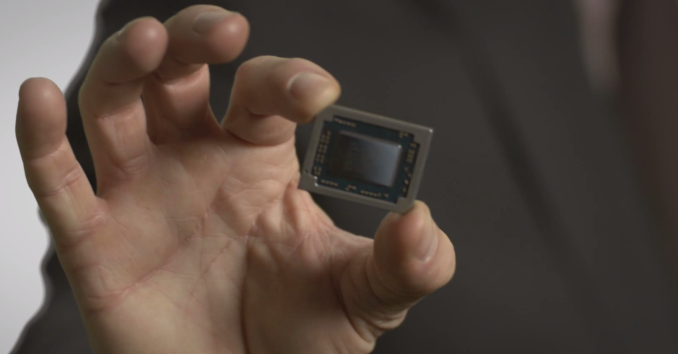
Today AMD is announcing the long anticipated upgrade to Kaveri, codenamed Carrizo. Carrizo is the natural successor to Kaveri, featuring x86 ‘Excavator’ cores alongside a Radeon-class GPU and promising an increase in performance all around. The second part of today’s announcement is for Carrizo-L, an SoC pairing “Puma+” (upgraded Beema) cores also with AMD’s R-series GCN GPUs and a FCH into a single package. Both Carrizo and Carrizo-L will feature ARM Trustzone, giving potential hardware-based built-in security when used by developers.
The Excavator cores are an architectural improvement over Steamroller, but are fundamentally based on the original Bulldozer concept. Excavator will be AMD’s fourth iteration of the concept, following Bulldozer, Piledriver and Steamroller. This new generation of APUs are still set to be built on the 28nm Super High Performance process at Global Foundries, delaying AMD’s shift to 20nm, but AMD are still claiming that the new GPU in Carrizo is their best yet, giving better performance and efficiency than before.
Given AMD's discrete GPU lineup, the GPU for Carrizo could be based on AMD's latest GCN 1.2 architecture, which was first introduced in the desktop Tonga part earlier this year. GCN 1.2's lossless delta color compression algorithms help improve the performance in memory bandwidth limited scenarios, such as in APUs. This could result in a bigger-than-expected jump in performance, although we will wait until we can test to find out how much it helps.
The Carrizo platform will be fully HSA 1.0 compliant, compared to Kaveri which only had ‘HSA Features’, as AMD puts it in their latest mobility roadmap update:
The push from AMD into HSA compliant APUs was well documented back at the launch of Kaveri earlier this year. This enabled the CPU and GPU components of the silicon, while under OpenCL 2.0 mode, to have access to the main block of system DRAM with zero-time copy functions, offering the potential for large classes of applications especially those in the prosumer and industry space to be accelerated by having instant access to the parallelization afforded by the GCN GPU. One of the big drawbacks of being an earlier adopter to HSA, as we noted at the time, was that software developers required time to bring their code to market, as well as AMD having to go out and teach the developers how to cater for HSA topology.
Both Carrizo and Carrizo-L on the mobile side will be targeted at the same power bands as Kaveri and Beema, although the socket will be new. The use of FP4 BGA also indicates that a single socket will cater for both the Excavator and Puma+ based APUs and would be interchangeable. A video by AMD’s VP/GM for Computing and Graphics, John Byrne, states that Carrizo and Carrizo-L are currently being tested internally ready for a 1H 2015 release, along with support for DirectX 12, OpenCL 2.0, Mantle and Freesync.
One of the big features that AMD is pushing with Carrizo is energy efficiency, with it being a keystone of the message. Because AMD have been on the same process node for a short while, they have to essentially follow the Maxwell example, by providing more performance for less power without the advantage of shrinking resistors. We were provided with an energy efficiency roadmap as well, showing the different methods AMD is using to achieve this:
One example of the efficiency improvement was provided by AMD’s Voltage Adaptive Operation. Rather than compensate for voltage variations which wastes energy, this technology takes the average operating voltage and detects when the voltage increases beyond a smaller margin. To compensate for this increase, the CPU speed is reduced until the voltage drops below the threshold and then the CPU speed is moved back up.
The changes in speed are designed to be so minute that it does not affect overall performance, however it might only take an errant voltage delivery component to consistently make the voltage go above that threshold, causing erratic slowdown that might be statistically significant. It will be interesting to see how AMD implements the latest version of this feature.
The 2015 desktop roadmap remains unpublished so far. AMD’s perception of a mobile-focused strategy would tend to suggest that the mobile comes first, with desktop following behind, although at this point it is unclear. A number of AMD’s marketing materials with this launch gave examples of the use of Carrizo and HSA for the prosumer, indicating that a desktop version should be announced in due course.
As of yet there was no discussion on the APUs to be launched, the speeds or the capabilities. All the roadmap tells us is 'up to four cores' (Excavator for Carrizo, Puma+ for Carrizo-L), some GCN compute units and 10-45W overall. There is no mention of DDR4 support, although the timeframe might be relevant for AMD to make the jump. Given the launch is still at least two quarters away, I would expect better details in due course. That timeframe fits in nicely around or just after Computex, perhaps indicating more details then.
Source: AMD


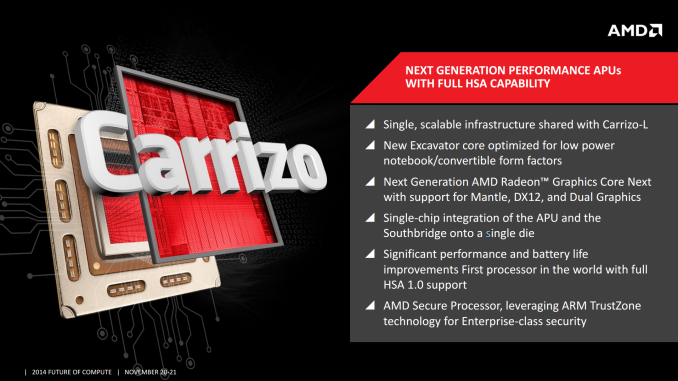
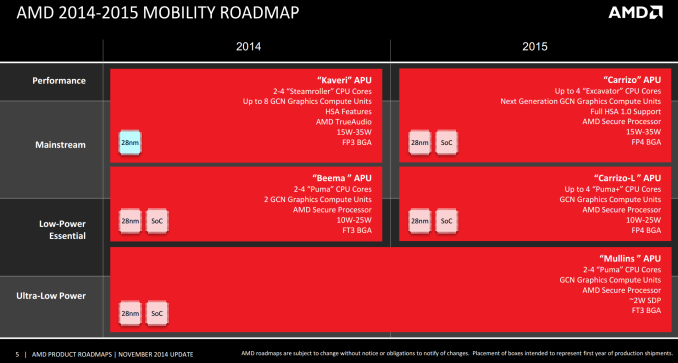
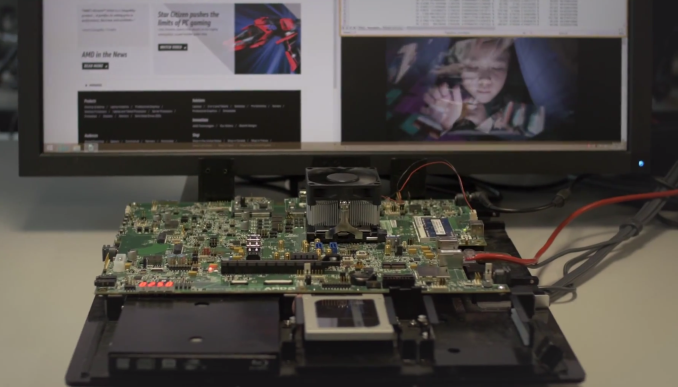
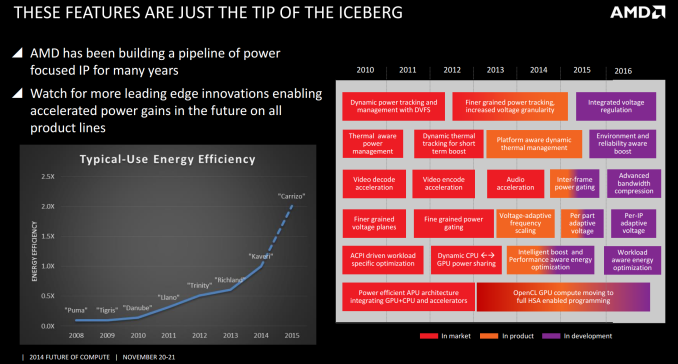
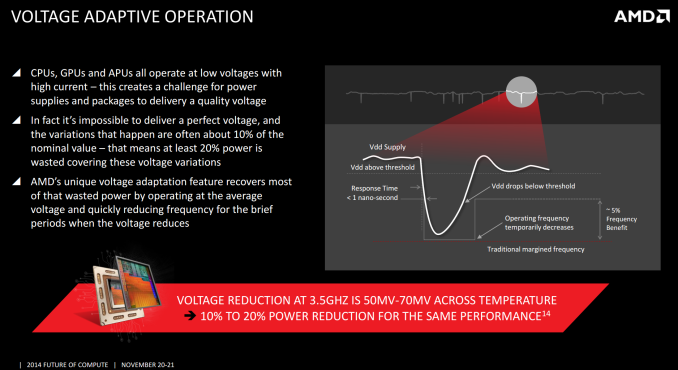
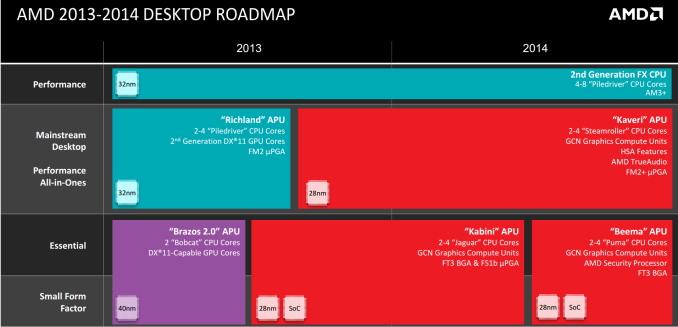








94 Comments
View All Comments
asimov1979 - Friday, November 21, 2014 - link
I think Low Power chips will be complemented with 20nm Skybridge SOCs which should be more competitive with Intel's 14nm.Morawka - Friday, November 21, 2014 - link
what your looking for is a PS4 chip for sale to everyone. Not gonna happen anytime soon. They are very limited by TSMC's massive 20nm delay just like everyone else.. This is a +1 update, designed to lower Perf. Per watt.Frenetic Pony - Friday, November 21, 2014 - link
You... wow. Literally. What? What in the hell are you talking about? Literally everyone but Intel is stuck on 28nm, Apple snapped up all early run 20nm stuff because they're Apple. This is also just and a brief APU announcement, not a lineup and detail of every product they hope to deliver next year.This is why Anandtech's commenting system sucks. If "Crazy" is the first post it always sucks up a disproportionate amount of the conversation.
gruffi - Friday, December 5, 2014 - link
The competition is perfecting it's 14nm production? No really. 14nm looks quite disastrous for them at the moment. Postponed several quarters, very low yields, lower than expected performance. That's why they launched only Core M so far. And even this one sux considering expectations and availability.And no, 28nm doesn't tells us anything about Carrizo. There are very interesting improvements. Excavator, new graphics architecture, HDL, first APU with full HSA 1.0 support, first true SoC based on Bulldozer and maybe even HBM as option. These are very attractive chips for most OEMs and consumers. OTOH no one wants a 250W TDP APU.
nt300 - Wednesday, January 7, 2015 - link
You cannot compare Intel with AMD. Intel is huge with mass resources, despite AMD has always been a lot more innovative in the last 10+ years. AMD was always slower with nm production. Intel caught up and surpassed them when AMD fumbled the Bulldozer. The very hype of the Bulldozer design forced Intel to develop what we have today.Both obviously need each other, to keep each other on there toes.
TheinsanegamerN - Thursday, November 20, 2014 - link
after the kaveri based fx-7600p appeared in exactly 0 laptops, i wonder if these chips will every appear in anything, or if amd will just completely give up? or release a laptop of their own, to show OEMs how to do it right (similar to google's nexus line)Gadgety - Friday, November 21, 2014 - link
Looks like they're mainly appearing in cheap desktop kits, using suboptimal 1600MHz memory modules. I fully expected SFFs with Kaveri chips.rocketbuddha - Friday, November 21, 2014 - link
AMD made a fatal mistake with Kaveri. It released a desktop variant first, followed 2 quarters later with a latop/mobile variant. By that time, Intel cleaned its mobile clock with subsidies and good products.So Baytrail is worse than Beema, but smaller and cool running than Beema and comes with good "contra-revenue incentives" that makes a OEM/ODM salivate.
While everything Kaveri was designed for like configurable TDP. Good gaming performance for the power envelope were all designed for mobile environment rather than desktop.
Even today if you go to www.amd.com and go to "Shop AMD Desktops" and chose the big OEMS like HP, DELL, Lenovo, Acer you cannot find a single Kaveri desktop. They still sell Richland desktops but no Kaveri ones.
You have to find III tier OEMs like Cyberpower, iBuyPower for Kaveri APU based desktops.
When I look for Kaveri notebooks I see only this. A HP notebook with average configuration sold for a humoungous price from a PCC.
http://shop.amd.com/en-us/search/K0L62UPABA
AMD is now in a very bad situation. The OEMs that buy bulk of their products are not interested in their latest and greatest instead, if interested 1(Richland) or 2 generations (AMD E2) behind the current one.
Go figure!
coder111 - Wednesday, December 10, 2014 - link
This! I'd love to buy a decent laptop with recent AMD APU + AMD dGPU, but there is simply nothing on the market. I run Linux, and I don't want to deal with Nvidia binary drivers. All-AMD solution has working open-source drivers, and decent GPU performance. Intel has good open-source drivers and crappy GPU performnace. Intel CPU + AMD dGPU would be another option, but I prefer all-AMD.The only things I can find are MSI gaming laptops. Or some low end crap from HP, which has weird arrow key layout which is highly annoying for me.
ruthan - Thursday, November 20, 2014 - link
I dont believe too much that AMD is able deliver something with better performance per watt than Intel or ARM, i think that this time passed.